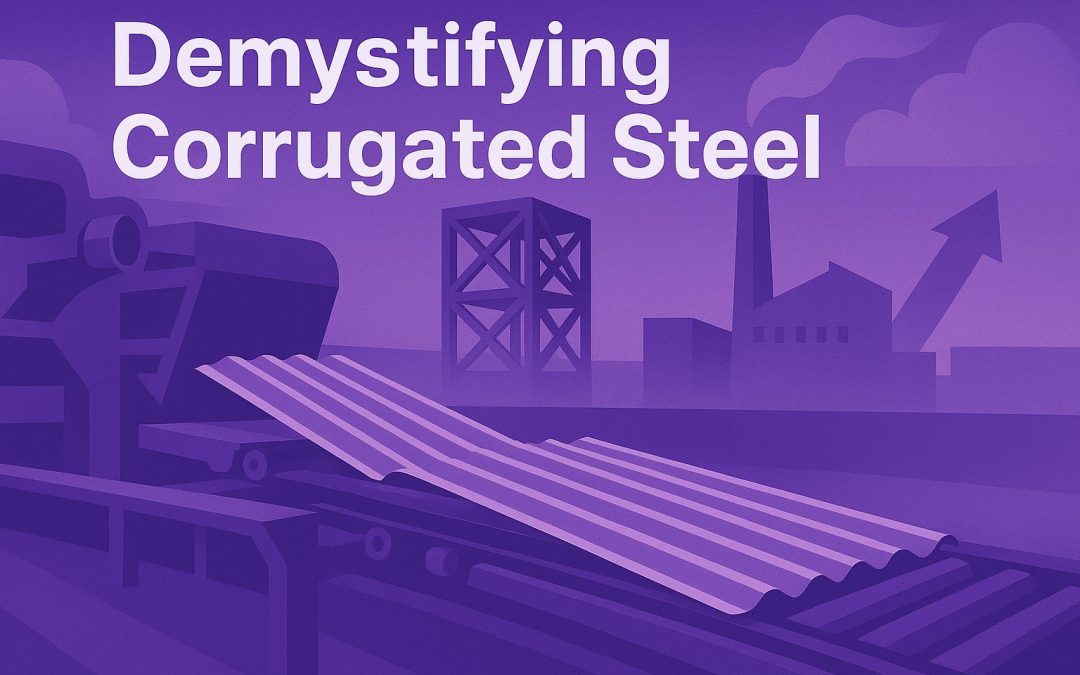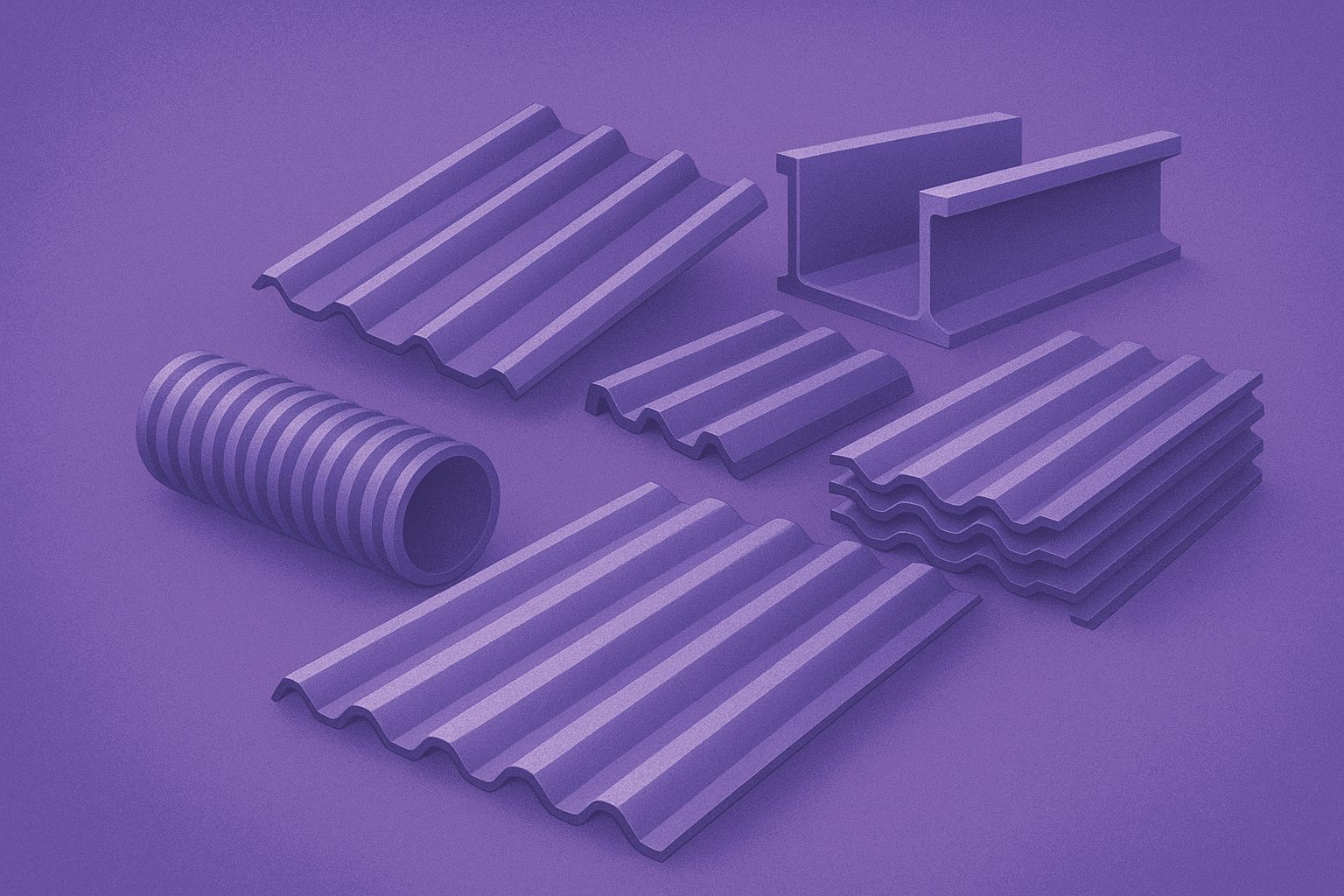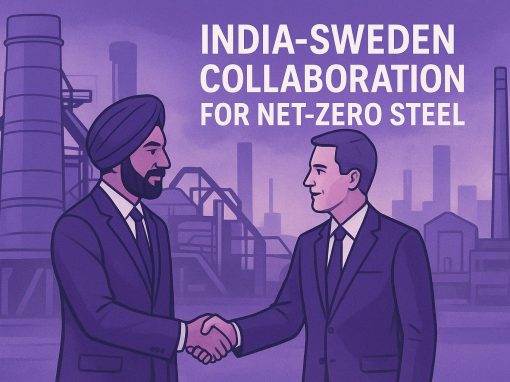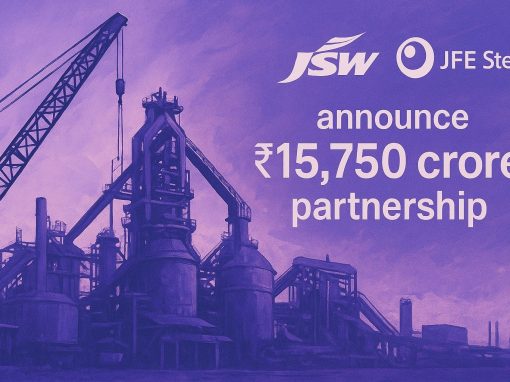Table of Contents
- Meaning of “corrugated”
- Types of corrugated materials
- Industry applications of corrugated materials
- Corrugated sheet manufacturing process
- Corrugated steel sheet price
- Outlook & forecast: Corrugated steel in india (2025–26)
- Corrugated steel vs. alternative materials: Cost, life & performance
- Conclusion
Corrugated steel sheets and pipes remain essential across India’s construction and industrial sectors, supported by rising project activity and shifting steel prices. Their relevance continues to grow as buyers look for materials that balance durability, cost efficiency, and reliable performance.
Corrugation simply refers to adding ridges or wave-like folds to a material, increasing its strength without adding much weight. This structural advantage makes corrugated steel ideal for roofing, wall cladding, and drainage systems, where impact resistance and long life are key requirements.
Across both urban and rural markets, corrugated materials are valued for being affordable, protective, and long-lasting – qualities that keep them in demand even as market conditions evolve.
Meaning of “corrugated”
Let’s begin by understanding corrugated meaning. A simple definition of corrugated materials would refer to any material (e.g., steel, cardboard, etc.) with wave-like folds and ridge patterns crafted on it using a corrugated roll. This results in a fluted corrugated sheet between two flat liner boards. The corrugation process enhances the material’s strength, robustness and resilience.
Types of corrugated materials
| Material type | Key features | Common uses |
|---|---|---|
| Corrugated steel | High strength, corrosion-resistant (especially GI/colour-coated), long lifespan, supports heavy loads. | Roofing, wall cladding, drainage pipes, industrial sheds, agricultural structures. |
| Stainless steel corrugated | Superior durability, heat and chemical resistance, premium performance. | Chimney ducts, flexible piping, specialised roofing, industrial applications. |
| Galvanised steel corrugated | Zinc-coated for rust protection, cost-effective, highly weather-resistant. | Roofing sheets, fencing, rural construction, warehouses. |
| Colour-coated steel corrugated | Aesthetic finish + corrosion protection, available in multiple thicknesses. | Residential roofing, commercial facades, warehouses. |
| Corrugated cardboard | Lightweight, recyclable, shock-absorbing, low cost. | Packaging, cartons, product protection. |
| Corrugated plastic (PP/PE) | Waterproof, lightweight, chemical-resistant. | Temporary partitions, signage, reusable packaging. |
Industry applications of corrugated materials
As mentioned previously, corrugated materials are extensively used in the construction and packaging sector. Their distinct grooves and ridges enhance their protective capabilities making them suitable for packaging of heavier, bulkier goods.
Let’s look at some examples of corrugated steel and other materials in construction, packaging, and other industries:
1. Construction sector
The role of steel in the construction sector can be seen across the spectrum. Corrugated steel sheets are often used for its robustness, versatility, and strength.
Its most popular application is for roofing and siding. Since its surface comes with a ridged pattern, it is excellent in letting excess water runoff. Moreover, with the right coating it can also resist corrosion and rusting, ensuring structural integrity in the long term. Corrugated roof sheets also have aesthetic appeal adding to elegance in roofing solutions.
Based on the thickness of these sheets, they can be used for domestic (0.42 BMT), commercial (0.48 BMT) and industrial (.60 MBT) roofing applications.
2. Packaging Sector
Another sector where we can witness the extensive use of corrugated materials is the packaging sector. From cardboard to boxes, there’s need for corrugated materials in various forms of packaging.
These materials are lightweight and provides moderate cushioning to items, making them invaluable for safe and secure shipping and transportation. Based on the type and thickness of corrugated materials, they can be used for packing heavy industrial items to light electronic goods (e.g., TV or computer screens).
Corrugated boxes moreover are economical, easy-to-customise, recyclable and reusable. Eco-friendly packaging solutions enable businesses to stay environmentally aligned and contribute to the country’s vision of sustainability.
3. Drainage systems
Corrugated steel pipes are also used for efficient water management and drainage systems.
Due to their ridged surface, they can prevent flooding and erosion. Depending on the degree of stormwater management required, the size, thickness and grade of the pipes can be adjusted (using corrugated rolls) to increase the ridges and grooves. This ensures stability and continuity in urban and rural landscapes.
In domestic and commercial drainage systems, corrugated steel pipes are used for flexibility, strength and corrosion resistant properties. These pipes are flexible and can be bent at required joints, making it easy to install. The pipes are moreover corrosion resistant and can seamlessly carry water from drains and gutters to their disposal spot, ensuring that there’s minimum leakage or stench.
4. Agriculture sector
Corrugated materials have also usage in the agricultural sector.
- Corrugated roofing solutions are used in food grain storage sheds to keep the grains protected from harsh weather (heat) and humidity, to prevent damage and wastage.
- Corrugated boxes are often used for the transportation of food materials. Since these boxes are lightweight, customisable, and provide cushioning to goods, it’s convenient to use them for packaging, preventing breakage and food contamination.
5. Fashion and apparel
Logistics plays a critical role in textile, apparel and fashion industry. Logistics is involved across all processes, from production planning to warehouse management and transportation.
In all these stages, it’s essential to ensure the safety of goods through appropriate packaging, and corrugated boxes are often the right choice.
They are easy to move, customisable, and eco-friendly. Moreover, when using for e-Commerce shipping or B2B deliveries, the boxes can be branded with the company logo and other contact details. This gives the packaging its uniqueness, creates brand awareness, and also enhances the unboxing experience for the customer.
Apart from the industries mentioned above, corrugated materials especially for packaging are used across healthcare, E-commerce, automobile and other sectors.
How are corrugated sheets manufactured?
When it comes to the manufacturing of corrugated sheets, the process is determined by the choice of material – i.e., steel, plastic, or cardboard.
Let’s take a look at steel corrugated sheet manufacturing for simplicity:
- The process begins by selecting high-grade steel coils. This is important since it will determine the end quality of the sheets. Alternative base metals can also be used, where it has to be melted first and then shaped into coils.
- The coils will next undergo flattening through the roll-forming machines. This step adds its unique ridges and gives it its desired grade and thickness. Corrugated sheet rolls therefore are more rigid and comes will more surface area offering enhanced stability. (Also read: Steel bending machines)
- Once corrugation is completed, these are cut into desired shapes as per project requirements.
- The sheets are next treated for enhancing their properties. Surface treatment can involve painting, galvanising, waterproofing or UV protective coats.
- As a last step, the corrugated sheets are checked for quality. This is done to ensure that it meets the standard requirements.
Corrugated steel sheet price
As in all cases, the prices will vary between location and manufacturers, and on the base material, size and thickness of steel. Here’s a quick look:
| Corrugated sheet type | Thickness/ size | Approx. Price (₹ / kg)* |
|---|---|---|
| Stainless-steel corrugated sheet | 0-2.0 mm | ~₹ 65–85/kg — based on Kamdhenu stainless roofing sheet rate. |
| SS corrugated sheet (galvanised) | 0.3 – 0.6 mm | ~₹ 40–55/kg — in line with general corrugated/GI sheet roof-sheet pricing. |
| Galvanised corrugated sheet (stainless) | ~0.45 mm | ~₹ 95–120/kg — inferred from galvalume / galvanized roofing sheet rates. |
| Galvanised corrugated roofing sheet (mild steel) | ~0.5 mm | ~₹ 40–55/kg — matches common roofing sheet range for corrugated steel. |
| HR (hot-rolled) galvanised corrugated sheet (mild steel) | 0.2 – 2.0 mm | ~₹ 40–60/kg — similar to range reported for general corrugated steel sheets. |
| Galvanised corrugated roofing sheet (white) | ~0.45 mm | ~₹ 50–65/kg — white/colour-coated variants of GI roofing sheet tend to fall in this upper range. |
| Colour-coated corrugated steel sheet (standard) | ~0.5 mm | ~₹ 95–110/kg — Kamdhenu’s colour-coated roofing sheet (0.40 mm) is at ₹95–110 / kg. |
| Colour-coated mild steel corrugated sheet (grey) | 0.2 – 2.0 mm | ~₹ 100–115/kg — for example, Kamdhenu grey color-coated sheet is quoted at ₹100–115/kg. |
| Colour-coated corrugated steel sheet (red) | 0.2 – 0.8 mm | ~₹ 112–124/kg — based on Kamdhenu red-/colour-coated roofing sheet pricing. |
| Colour-coated corrugated steel sheet (blue) | ~0.5 mm | ~₹ 95–110/kg — similar to standard colour-coated rate; can vary based on coating. |
* Prices are indicative, based on ex-yard rates from distributors. They may not include GST, transport, or any premium for volume orders.
Notes:
- Variation by Brand: Prices differ significantly by manufacturer. E.g., Kamdhenu vs. Jindal vs Tata and by thickness, gauge, and coating.
- Additional Costs: Transport, GST, loading-unloading, and freight can add substantially to the “yard rate.” Ex-yard prices are what’s typically reported by distributors.
- Market Fluctuation: Steel prices remain volatile due to raw-material (iron ore, zinc) and transport costs. Use these as benchmarks, not fixed values.
Drivers behind current corrugated steel price trends
Weak demand dragging down flat steel prices
Market reports indicate that HRC and CRC prices remain under pressure because demand from construction, infrastructure, and manufacturing has been softer than expected. This directly reduces the baseline cost for corrugated sheets.
Oversupply adding price pressure
Producers continue to maintain high output levels, leading to oversupply in the flat steel market, which pushes prices down further and keeps corrugated sheet rates from rising.
Zinc price fluctuations affecting galvanised sheets
Zinc, used for galvanising, has shown intermittent volatility. Even when base steel prices weaken, higher zinc costs can inflate the final price, particularly for GI and colour-coated corrugated sheets.
Raw material and freight costs impacting mills
Iron ore, coal, and transportation make up a large portion of production costs. Recent freight and fuel cost variations, combined with input cost changes, influence mill pricing and create uneven movement across product categories.
Steel buying tips for 2025
-
Negotiate bulk orders smartly: With prices fluctuating, buyers can push for better rates on larger quantities. Consider locking in prices for part of the order to hedge against future spikes.
-
Use mixed purchase strategies: Combine spot buying (for immediate needs) with forward or long-term contracts to secure stable pricing for the next few months.
-
Check coating quality and zinc weight: Ensure the zinc coating (GSM), colour coating thickness, and galvanising quality meet industry standards. These factors directly affect sheet lifespan and corrosion resistance.
-
Verify supplier certification: Prefer suppliers with ISI/BIS certification, mill test reports, and consistent quality records to avoid low-grade or under-coated material in the current price-sensitive market.
Outlook & forecast: Corrugated steel in India (2025–26)
Demand outlook
Infrastructure spending rising: Housing, rural development, smart city upgrades, industrial sheds and warehousing continue to boost consumption of corrugated roofing and cladding.
Renewables push: Solar and wind projects need lightweight, durable structures – supporting steady demand for galvanised and colour-coated corrugated sheets.
“Make in India” momentum: New factories, logistics parks, and MSME expansions will keep orders strong for roofing, drainage pipes and structural coverings.
Price forecast
Possible price softening (downside factors):
- Better availability of iron ore and steel coils
- Oversupply in flat steel (HRC/CRC), which acts as input for corrugated sheets
- Manufacturers improving capacity and efficiency
Possible price increases (upside risks):
- Fluctuations in zinc (key for galvanising)
- Higher freight and fuel costs
- Tightness in coking coal or other raw materials
- Environmental compliance costs for mills
What to Expect Overall
Demand: Solid and growing across construction, renewables and manufacturing.
Prices: Mostly stable but with periodic spikes triggered by raw material or logistics disruptions.
Buyer strategy: Mix of spot + forward purchases, careful specification checks (zinc weight, coating quality), and negotiating stability clauses in contracts
Corrugated steel vs. alternative materials: Cost, life & performance
| Material type | Approx. cost (indicative) | Lifespan | Strength & durability | Weather resistance | Best use cases |
| Corrugated steel | Moderate; ₹85–125/kg (Nov 2025 range varies by coating & thickness) | 20–40 years | High strength, impact-resistant. | Excellent with galvanising/colour coating. | Roofing, siding, drainage pipes, industrial sheds. |
| Aluminium sheets | Higher than steel | 30–50 years | Good strength, lightweight. | Very good corrosion resistance. | Coastal regions, premium roofing, lightweight structures. |
| Polycarbonate sheets | Moderate to high depending on grade | 10–20 years | Good, flexible, and lightweight. | UV-resistant but can yellow over time. | Skylights, greenhouses, architectural roofing. |
| Concrete roofing (RCC/sheets) | High (material + labour) | 40+ years | Very high but heavy. | Very good once sealed. | Permanent building roofs, industrial structures. |
| Corrugated cardboard (packaging) | Low | Single-use to short-term | Moderate cushioning only. | Sensitive to moisture. | Packaging, logistics, E-commerce, FMCG. |
Conclusion
Corrugated steel remains a critical material for India’s construction and industrial needs in 2025. With shifting demand, volatile zinc prices, and changing raw material costs, staying informed is essential for smart procurement.
Prices are expected to stay mostly stable but can move quickly with supply disruptions or freight spikes. Buyers should compare suppliers, check coating quality, and monitor market updates regularly.
A balanced mix of spot purchases and long-term contracts can help manage risk. In a fluctuating 2025 market, informed decisions will ensure better value, durability, and project reliability.
Looking to procure steel?
Tata nexarc helps manufacturers, builders and MSMEs source certified steel products, compare prices, and choose the right grade as per IS codes—with complete traceability and procurement confidence.
FAQs
What does “corrugated” mean?
Why is corrugated steel popular in India?
What materials can be corrugated?
What are the main uses of corrugated steel sheets?
How are corrugated steel sheets manufactured?
What affects corrugated steel prices in 2025?
Which type of corrugated sheet is best for roofing?
How do I choose the right corrugated sheet thickness?
What should buyers check before purchasing?
Are corrugated sheets recyclable?
Sohini is a seasoned content writer with 12 years’ experience in developing marketing and business content across multiple formats. At Tata nexarc, she leverages her skills in crafting curated content on the Indian MSME sector, steel procurement, and logistics. In her personal time, she enjoys reading fiction and being up-to-date on trends in digital marketing and the Indian business ecosystem.








I’m a DIY enthusiast, and I’d love to know if there are any projects I can tackle with corrugated materials. Are there any simple instructions available online for making things like corrugated planters or decorative panels for my garden?
I am thinking to setup a small plant for its manufacturing, what size of money, i would need for it?